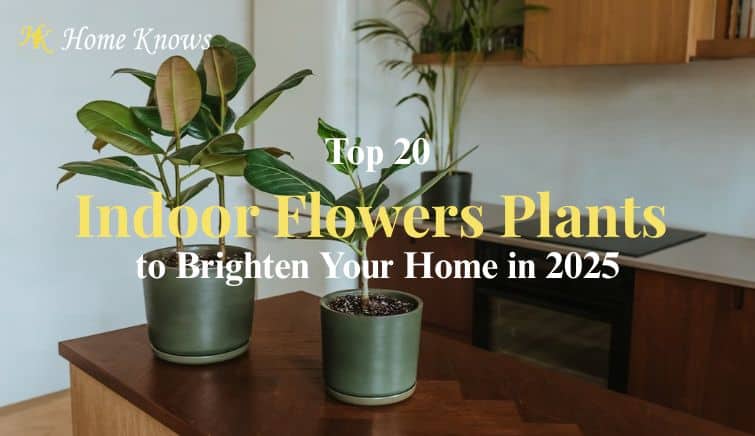Introduction
“Indoor flowers plants prove that even within four walls, nature finds a way to bloom.” – Anonymous.
Why settle for mere green when you can fill your home with vibrant, blooming beauty? Indoor flowers bring a touch of nature’s charm into your living space. With delicate petals, lush foliage, and air-purifying benefits, they create a soothing atmosphere.
From elegant orchids to cheerful geraniums, indoor flowers with fragrance can add both color and a refreshing aroma to your home. Whether you’re looking for indoor flowering plants with no sunlight, low-light bloomers, or small indoor flowers for compact spaces, this list has it all.
If you’re ready to give your home a fresh floral makeover, let’s explore the best indoor flowers for 2025.
Benefits of Indoor Flower Plants for Home
They have excellent benefits that will do wonders for your physical and mental well-being. They’re little friends that can make a big difference in your daily life.
Studies have revealed that being near plants can lower your blood pressure and relax you. And let’s not forget the sense of accomplishment you get from caring for plants! All in all, it will be more than a home decor item.
Indoor flower plants for home do wonders for your well-being. They not only enhance your décor but also improve air quality, reduce stress, and promote relaxation.
Air Purification
Many indoor flowering plants act as natural air filters. They absorb pollutants like volatile organic compounds (VOCs), making the air cleaner and healthier. Plants like the Peace Lily and Spider Plant are excellent choices for this.
Stress Reduction
Feeling overwhelmed? Surrounding yourself with indoor flowers can help. Studies have found that just being around greenery can lower anxiety levels, lower blood pressure and set up a tranquil atmosphere.
Caring for your plants, watering them, trimming leaves, and witnessing them grow is therapeutic. It’s less about getting away from the craziness of life and more about just slowing down a little bit.
Improved Sleep Quality
Some indoor flowers like lavender and jasmine have soothing aromas that help improve sleep. Others, like the snake plant, release oxygen at night, ensuring cleaner air while you rest.
Boosted Productivity
Have you ever wondered why you see plants in offices and workspaces? It’s not for aesthetics only. Plants can increase productivity! Indoor flower plants in the workspace help the mind stay focused at the workplace, help boost creativity, and increase productivity.
They assist in regulating humidity, creating a more pleasant environment. Less distraction, cleaner air and a more congenial workplace? Sounds like a win-win.
Sense of Accomplishment
There is something immensely gratifying about caring for a plant and seeing it flourish. Whether you are a seasoned plant parent or new to the habit, tending to greenery puts you in a position of responsibility and accomplishment. It’s an easy yet satisfying hobby that brings pleasure and calm and is a daily reminder of holistic progress.
Healing & Recovery
There’s a reason hospitals and healthcare spaces frequently have indoor flower plants. They promote healing! Studies show that patients who are surrounded by greenery rehabilitate faster and experience less pain and anxiety (we’re talking horticulture therapy here!). As much as it is also suitable for having plants around the house, it can also help you keep comfortable inside, bringing just a little touch of nature so you can feel much better.
Noise Reduction
Do you live on a busy street or have noisy neighbours? Your plants may be able to lend a hand. Some broad-leafed indoor flower plants, such as the rubber plant and peace lily, absorb sound, which helps reduce noise levels for a quieter and more peaceful home. They function as natural buffers, absorbing harsh sounds and making rooms cosy.
Aesthetic Appeal
Beyond health benefits, indoor flowers brighten up spaces with their beauty. Whether you choose small indoor flowers for your desk or large ones as statement pieces, they make your home visually appealing.
Top 20 Indoor Flowers Plants
Here’s a list of the best indoor flowers that are easy to care for and perfect for any home.
Jasmine
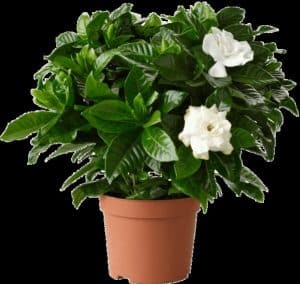
This fragrant flower is a perky sun-lover that will add an elegant touch to your indoor garden. Jasmine flowers come in various colours, but the most familiar is a crisp white Jasmine flower.
Two of the easiest to grow are flowered jasmine (J. polyanthum) and Arabian jasmine (J. sambac). They will produce fragrant pink to white flowers on vining plants. These are among the most perfumed indoor flowering plants you can get.
Gloxinia
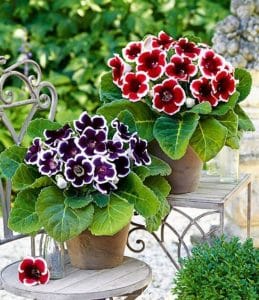
A vibrant choice among small indoor flowers. This indoor flower plant is all set to be your show-stopper. Its flowers are available in various shades, including pink, red, and white, among others, and the leaves are large and velvety.
They’re great houseplants, and you can usually look forward to seeing the blooms from late spring through summer. When blooms fade, let the plant become dormant by withholding water. You can water again when new growth starts up again.
Chrysanthemums

Popular for their bold colors, chrysanthemums are excellent indoor flower plants for home decor. Chrysanthemums, or mums, are flowering perennials that come in all kinds of jewel tones, making them huge in the fall. The ideal time to plant mums is spring, and if grown indoors, they need to be positioned so they get bright light all day and good air circulation.
It doesn’t often happen when they’re living inside, but it can be done! Mums bloom once, either in the late summer or early fall season. Also, these indoor flower plants generally last three to four weeks and are available in numerous bright colours. These flowers often bloom around certain seasons, and interestingly, they’re also featured in lists of birth month flowers due to their symbolic nature.
Regal Geranium

Geraniums are perfect indoor flowers with fragrance. Regal geraniums bloom in many colors. Their green serrated leaves frame the flowers nicely. They do best in bright, indirect light (and prefer slightly cooler environments). The common garden geranium (P. x hortorum) and ivy geranium (P. peltatum) have bright flowers. They are also easier to grow.
Crown of Thorns
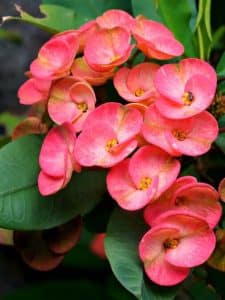
The crown of thorns, or Euphorbia milii, is an impressive tropical succulent shrub. It bears pink, white, yellow, or orange flowers. It requires low-light indoor flowers conditions and minimal watering, making it ideal for busy plant lovers.
As a succulent, which means it holds water, the indoor flower plant needs a drink just when the top inch or two of soil feels dry. If you’re drawn to soft-toned florals, you’ll love these pink flowers that can add charm to any corner of your home.
Desert Rose

Desert roses are also beautiful succulents with big, trumpet-shaped flowers. It prefers bright light but can also adapt as an indoor flowering plant with no sunlight for short periods
Because it’s a succulent, don’t overwater: only when the top couple of inches of soil feel dry. Indigenous to Africa, the Middle East, and Madagascar, it thrives in warm climates and is widely cultivated indoors in cooler areas.
Bromeliad
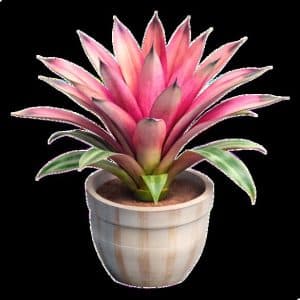
Bromeliads are spiky, fun and funky indoor flower plants related to pineapples. The eye-catching flower, or bract, lasts for an extremely long time. It requires plenty of bright, indirect light (it won’t tolerate low light) and water every one or two weeks. You need to allow it to dry out between waterings.
This pineapple family member has stiff, glossy green, toothed leaves arranged in a curved vase shape. They have flowering shoots that come out of the centre of the leaves. The flowers can remain in bloom for as long as six months.
Cyclamen

This sweet plant has heart-shaped leaves and lovely butterfly-shaped flowers. They add a splash of color during the winter months. They thrive in bright, indirect light and like to remain slightly moist. Yet, these indoor flower plants become dormant, like shamrocks.
So, you can store it in a cool place, forget about it for two months, then bring it back into the light and start watering it again. If all goes well, it will bloom again. If that seems like a lot of effort, enjoy it when it’s in bloom, then compost it when it fades.
Peace Lily
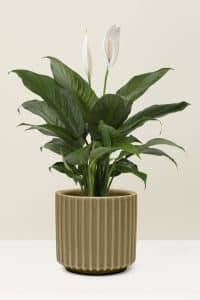
One of the best indoor flowers. This houseplant features shiny green leaves that are floppy and low-maintenance. It also has spoon-shaped white flowers on top, making it a classic choice. These plants will live for many years without much fuss with the right conditions.
Peace lilies can thrive in low to moderate light but bloom better in bright filtered light. Keep the soil lightly moist. The elegant white flowers of the peace lily (Spathiphyllum wallisii) may not be fancy, but they stand out. They rise above the shiny leaves on tall, slender stems. If you’re looking for more inspiration, here are some other beautiful white flower options for indoor spaces to consider.
Clivia

Clivia plants are native to South Africa. They have unique tube-like flowers that bloom in shades of pale orange to red. If grown outdoors, they need plenty of shade. When grown indoors as container plants, it does well in indoor flowering plants with no sunlight conditions and thrives in indirect light. So, place them in a south or west-facing window.
Clivia has long, arching, strap-like, dark green glossy leaves. The compact foliage grows up to 18 inches tall, forming a dense backdrop for the flowers.
Clivia miniata is the most popular species. It produces trumpet-shaped flowers in orange, yellow, and red. These flowers typically bloom in late winter to early spring and can last for weeks. Rare cultivars , including the yellow-flowered ones, are generally dearer.
African Violet
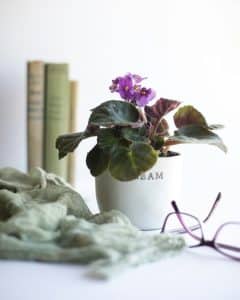
These compact, small indoor flowers bloom year-round in shades of purple and blue. African violets will flower year-round if you make them rapture in bright, indirect light. Water the soil lightly, and don’t let water drip on the fuzzy leaves, or it will leave brown spots. These gorgeous indoor flower plant bloom would do well in a self-watering pot. Some wear their blooms on long stalks, like a fishing line with a goldfish on the end.
Christmas Cactus
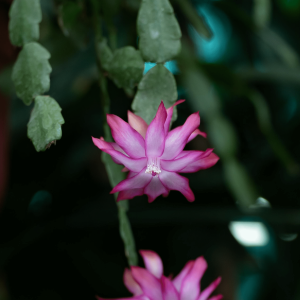
Christmas cactus (Schlumbergera) is a popular indoor plant. It blooms with bright flowers during the holiday season. This plant is different from most cacti. While many like dry areas, this one comes from Brazil’s damp rainforests. It grows in shaded spots among tree branches and rock crevices.
The plant has segmented, flat stems that look like leaves but are modified stems. These sections can range in colour from green to a shade of blue.
These indoor flowering plants require no sunlight. They can adapt to partial shade but should be kept away from direct sunlight, which can burn the leaves. An east-facing window is ideal. It lets morning sunlight in for your flower plant, but keeps out harsh afternoon rays.
Ixora
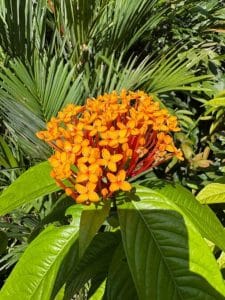
Ixora plants do well in humid climates. So, it’s best to keep them in a greenhouse, a sunroom turned into a plant room, or even a bathroom.
Known as West Indian jasmine, these tropical plants can bloom year-round if properly cared for. They love sunshine, so a bright spot in a sunny bathroom or laundry room would suit them well.
Ixora, also known as the flame of the woods, has bright orange, red, and yellow flower clusters in winter. Its leathery leaves are bronze when they first appear but become glossy green. Light pruning will compact this indoor flower plant if the stems get too leggy.
Rieger Begonia
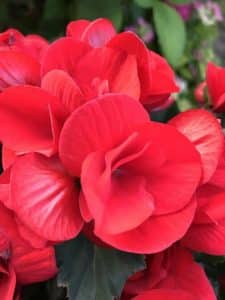
Rieger begonia (Begonia x hiemalis) is a low-maintenance plant that blooms in winter. It grows from a swollen base that looks like a tuber. The clusters of rose-like flowers are bright and rest on a neat mound of shiny, green leaves. There are varieties with flowers in warm shades from yellow to orange to red. It’s an excellent choice for indoor flower plants for home decor.
Kalanchoe
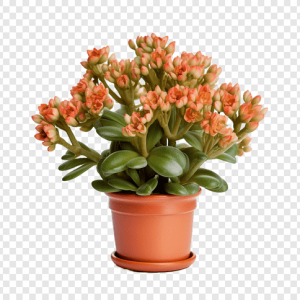
This succulent features clusters of bright red, yellow, pink, or orange flowers. They last for weeks and sit proudly above its glossy green leaves. It thrives in bright, indirect light and likes to dry out between waterings.
This Madagascar plant features thick, fleshy leaves and vibrant flowers. It’s a favorite for decorating homes.
Kalanchoe does well at temperatures between 65°F and 75°F (18°C to 24°C) and will die if temperatures dip below freezing. You can grow it indoors all year in cooler climates or outside in warm areas (USDA hardiness zones 10-12). It’s a great option for indoor flowering plants with no sunlight, as it adapts to various light conditions.
Snake Plants
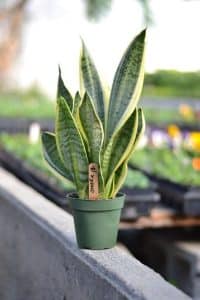
Snake indoor flower plants are among the most arduous, least fussy houseplants. They are mostly grown for their attractive, upright leaves. Still, they can also produce flowers when conditions are right.
Snake plants have tall, straight leaves. These leaves range from dark green to silvery green. They often show striking yellow or white edges. In the wild, they can reach a height of up to 2 m (6ft.), but indoors, they usually get an average height of 0.7 to 1 m (2.3 to 3.2 ft.). It’s one of the best indoor flowers for beginners due to its low-maintenance nature.
Anthurium
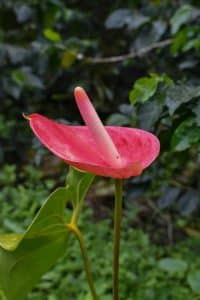
Anthuriums (Anthurium andraeanum) are great indoor flower plants. They need low light and are known for their striking appearance and unique flowers. Anthuriums feature glossy, heart-shaped leaves. Their vibrant flowers are really modified leaves known as spathes. The spathes are found in various colours, including red, pink, and white, lasting several months.
Anthuriums like bright, indirect sunlight. Though they like light over shade, they can get leaf scorch if given too much direct sunlight. Ideally, They should get six hours of bright, indirect light daily. It’s one of the most elegant indoor flowers.
Please Note: This isn’t a pet-friendly plant!
Phalaenopsis Orchids

Phalaenopsis, also known as moth orchids, are some of the best indoor flowers. They are loved for their beautiful blooms and low maintenance needs.
Phalaenopsis orchids have large, waxy flowers that can bloom for months. The blossoms come in many colors, like white, pink, yellow, and purple. They often have intricate designs, too.
Phalaenopsis orchids prefer high, indirect light. If possible, position them next to a south- or east-facing window. Supplemental grow lights can be used to sit beside them in case natural light is insufficient.
Purple Oxalis
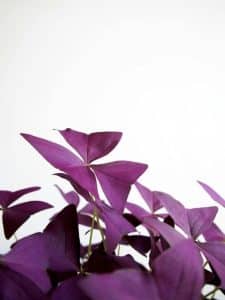
Shamrock plants or Purple Oxalis have profuse blooms of pretty little star-shaped flowers. The foliage of the plant can be either green or burgundy. This cute indoor flower has purple leaves that look like triangles or clovers. It folds down in the dark or in low light.
Above the foliage, a continuous display of pale pink or white flowers occurs. You can find oxalis varieties that have solid green foliage. Some may have silver highlights, while others are just green. It’s a charming addition to your collection of small indoor flowers.
Pothos
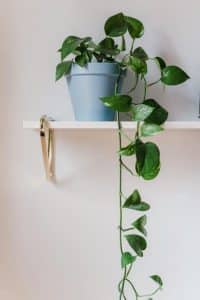
While primarily a foliage plant, pothos can occasionally bloom. It’s one of the easiest indoor flowers with low light options, requiring minimal care.
Care Tips for Indoor Flowers Plants
Now, let’s reveal some secrets to great indoor flower plant care! Select the right plants for your space. Then, learn the basics: watering, lighting, and pest control. You name it, we’ve got you covered with everything you need to know for a beautiful indoor flower plant garden.
Choose the Right Indoor Flower Plants
Select indoor flower plants for home based on your light conditions. South-facing windows provide the most sunlight, while north-facing rooms require indoor flowering plants with no sunlight.
You receive medium light in the east-facing/west-facing windows and low light in the north-facing windows. Select plants that match your skills and the time you can invest. This choice will lead to success.
Master Watering Techniques
Always take the watering needs into account. This will help you avoid both overwatering and underwatering. For watering, succulents should be done every 2-3 weeks. Orchids need water once a week. Ferns require watering 2-3 times weekly.
Maintain Proper Temperature & Humidity
Most houseplants prefer daytime temperatures of ≈ 60-75°F (15-24°C) and cooler at night. There are some steps you can take to increase humidity.
-
Mist your plants often.
-
Set up pebble trays filled with water.
-
Group plants close together.
-
Put indoor flowers in humid spots, like bathrooms.
Feed & Fertilize Indoor Flowers
Choosing the correct fertilizer is always essential for indoor flower plants. You can choose from options like Balance NPK (Nitrogen, Phosphorus, and Potassium), liquid fertilizers, slow-release granules, and organic fertilizers.
Timing fertilizing frequency is essential depending on the plant’s growth stage and season. Otherwise, give indoor flowers food every 2-4 weeks in the growing season. Always follow the package instructions for how much to use. Remember, when fertilizing indoor plants, less may work better.
Pruning & Grooming
Periodically remove dead or yellow leaves to keep the plant healthy and attractive. It helps stop disease spread, boosts air flow, guides energy to healthy growth, and makes the indoor flower plant look better.
You can also pinch to promote bushier growth. You can use proven techniques to help your plants thrive. For example, remove growing tips to encourage side branches. Pinch back new growth to create multiple stems. Also, regular upkeep keeps your plants compact and lush.
Preventing & Treating Pests
Indoor flower plants can fall victim to various pests. Here’s a quick guide to common culprits:
| Pest | Signs |
| Aphids | Sticky leaves, distorted growth |
| Spider mites | Fine webbing, stippled leaves |
| Mealybugs’ | White, cottony masses |
| Fungus gnats | Small flies around the soil |
Natural methods are also effective and eco-friendly, including neem oil spray, diatomaceous earth, soap & water solution, and the introduction of beneficial insects.
Repotting & Soil Management
If you notice a few signs, think it’s time to report! These symptoms are roots growing out of drainage holes and quick dying out of plants, stunted growth, and soil pulling away from the edges of the pot.
Choosing the right potting mix can make a big difference in your indoor flower plants‘ health. Research your plant’s needs and select an appropriate well-draining mix to hold moisture without becoming waterlogged. The right soil means your plants will flourish and develop in their new homes.
Bonus: Vermillionaire Plant – Indoor & Outdoor Charm
If you’re open to something a bit more versatile, the Vermillionaire plant thrives in bright spaces and can be grown both indoors and out. Its vibrant tubular flowers attract pollinators and bring energy to any space, especially balconies or near windows.
Conclusion
Indoor flower plants make all the difference in having a house or a home. They bring cosiness, clean the air and deliver a calming energy. Each has its magic: a bold statement plant or a tiny pop of colour. So why wait? Shop your favourites, and let your space grow beautiful in 2025!
FAQs
Which flower is best for indoors?
Peace lilies are another good indoor flower plant, as they will thrive even in low-light conditions and help to purify the air.
Which plant gives 12 months of flowers?
Kalanchoe is a flower that can bloom year-round with proper care and conditions.
What flowers are suitable for the living room?
Orchids, African violets, and Anthurium make aesthetically pleasing decorations in one’s living room.
Which plant is lucky for a bedroom?
Snake plants are commonly considered bedroom lucky. They are also thought to bring good energy and purify the air.
What is the longest-lasting indoor flower?
Our second choice for a long-lasting indoor flower plant is Pothos, a hardy perennial that will live for many years with little to no maintenance.
Which indoor plant is best for health?
Aloe Vera is considered best for its health benefits, such as air purification and medicinal benefits.
Is it reasonable to keep flowers in the house?
Yes, indoor flowers help to purify the air, elevate mood, and enliven your space with natural beauty.

